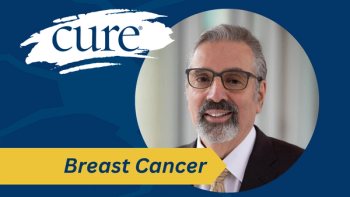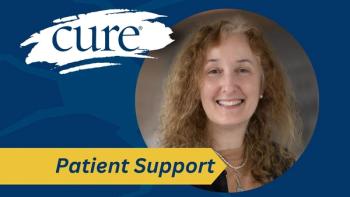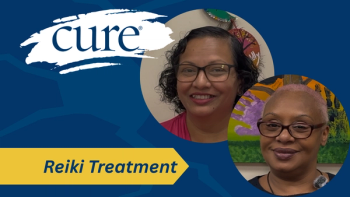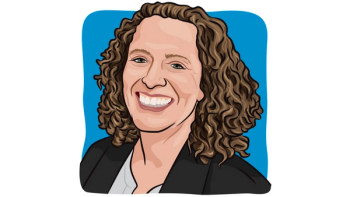
Knowing Your Community of Patient Navigators
Patient navigators are the vaunted “healthcare emissaries” for patients with breast cancer and can help navigate their journey a great deal. In this conversation from the Susan G. Komen Greater New York City “Empowering and Mobilizing Our Patient Navigation Workforce” virtual conference experts highlight the results of a survey of patient navigators.
Patient navigators are the vaunted “healthcare emissaries” for patients with breast cancer and can help navigate their journey a great deal. In this conversation from the Susan G. Komen Greater New York City “Empowering and Mobilizing Our Patient Navigation Workforce” virtual conference experts highlight the results of a survey of patient navigators.
Transcript:
This is actually a good segue to the scope of practice survey that Komen Greater New York City conducted with 250 patient navigators of all stripes earlier this year, and Dr. Klemp is going to give us a snapshot of where patient navigation stands in our service area and in Greater New York City. So over to you, Dr. Klemp.
Dr. Klemp: Well, as we talked about metrics are very important. And when Stewart described the survey, that's part of knowing your community. And I think the important part about these snapshots - and there's a lot of information I know that the Greater New York City affiliate will share more of this information - but we took out some of the key highlights that we thought were helpful and important, and the first was really, what type of navigators were out there and responded to the survey?
So about 41% have listed themselves as community health workers, and another 22% (identified as) lay navigators in a hospital setting. So about 65% were more of the lay or patient navigator of working more in the field, or not in a specialty or having a nursing background.
We also saw nurse navigation being a small piece, but when we go to the third bar down, so down here, we still see that a lot of this group is undergoing the different certifications that are available. So, we know through AONN and NCBC, you have certification for both nurse and non-nurse, or licensed or non-licensed, and there's a lot of different discussions around semantics. And I think that as we just heard, many community health workers, maybe they don't want to go through certification. That, I think, has the same semantics as the licensed and non-licensed. So, I don't want to speak on behalf of community health workers or lay navigators, but I think these are important semantics to be mindful of, because it shows that that a large percentage of respondents do have some sort of certification, do have some sort of degree that really supports their role and their scope of practice, but there are some, I think, nuances of how that fits into how they view themselves and the role that they play.
I think another important piece that you highlighted in your needs assessment is how young the field of navigation still is. If you look at those of us who work in oncology, we're an old workforce, right? We are an aging, shrinking workforce. And so, I didn't know when I converted that bucket, but apparently I have. So, I'm in the older bucket now. And so, when you think about those of us who've been in practice 20+ years, that's a shrinking percentage and a smaller piece of the workforce, whereas many of those drawn to fields of navigation or community health work, they're younger, and they're newer in their practice. Or, we see a lot of transition from someone who worked in a particular field or scope, and then they convert over. So, I think that these are important things to think about because we can always reinvent ourselves, but the other important piece is, well, what are the tools that we have available to help them as they sort of, reinvigorate their careers or start their careers in navigation or community health workers?
We do see a lot of across the board range in salary. This usually is a component of years in practice versus amount of education versus the type of employment. So, I think you're always going to have, as we said, sort of a pretty big range when it comes to salary. And I think that a lot of individuals work in a variety of types of organizations. Many, because probably responding to a common survey, are going to work in breast health outreach and screening. We also know that a lot of work for other community or hospital-based organizations extending that reach and care. We had a nice distribution. I probably I think our previous speaker, Karen, had something to do with your Westchester County response or, or maybe you had a bigger presence. But this is, you know, a nice distribution of respondents based on the counties that they work in and overlap.
And then, I think the other piece is do they follow any standards or reporting? So majority, a significant majority, almost 70% said yes, that they do follow some standards. So, I think the interesting part would be, okay, where do those standards come from? Are they from the employer? Are they from a professional organization they do align with? Is it from the discipline that they work within the scope of practice? So, there are some standards being followed. And I think when you already have that precedent, kind of, like we heard, from the previous discussion, then that really sets the foreground for the need for that standardization, because that's what helps people build their scope of practice, guide their principles, and help achieve the goals laid out for patient care.
And then the other piece that I think is a common problem for all of us, and even more so, by this pie chart in the top left, is how do people report this? How are they documenting? Documentation Is the bane of our existence oftentimes, right? So maybe we're documenting in a health record, but then we have to keep track in an Excel spreadsheet or a database. So there's often this duplicative sort of role of how we document something for direct patient care, versus where are we documenting the outcomes, and the metrics we need to document and it sure would be nice if they were the same, but that that's not often the case. And so that goes to that piece we talked about with compassion fatigue, which is increasing administrative duties, where we're spending more time doing documentation, then we are often sometimes doing that direct patient care.
Who do they share data with? You see a variety of where those metrics are being shared: from agencies, probably funders, obviously health insurance companies are a large group of that. With the care team, the oncologist the medical patient physician's assistant, PNPs. And so I think the important piece is that we do need to know what is required and why we're collecting the data. I assume because there's only a small percentage that required patient consent, that most of this is de-identified or it had better be, right? De-identified data, which is going to these entities, but maybe to a health insurance company, it's not it's actually identified data, or if it's to the healthcare team, it's identified data. So what are the metrics or standards around that? You know, do we have a standard of how we get consent from patients, whether that'd be oral or written? I think that's an interesting question and something to flesh out.
We also see a variety of types of professional training or formal programs from sort of self-taught classes that we take online to internships, on the job, and we do know that most of the of the experience that we get in healthcare is still on the job, right? You can be trained, and you can have a degree, but what you're going to learn is on the job, and with a younger workforce in navigation and community health workers, we don't have as many seasoned or experienced professionals that are part of that ‘train the trainer’. So I think that that could be enhanced as part of this. But it's, it's once again buried.
And then how do they get updates? And we talked about this with, with I think, our third session today, where we really asked, how are we pushing out this professional development and updated need to know information? And where are we getting these updates and how often are we getting updates for training? This is pretty varied as well. So, the accreditation standard maybe every two years, but that still means we have an online need for professional development. So where are we getting that? Are we getting it through organizations like AONN or other nursing or professional organizations? This is an important piece to think about too.
And then lastly, I think as we start thinking about, you know, how are we communicating?
So, we look at how we're communicating with our patients. A lot is already, you know, sort of phone contact telehealth. But now we're converting to more video-based, requiring more training of our patients and our staff.
The social determinants of health, I think are really important. What are the issues influencing our ability to support patients and economic stability, education. There's some consistent messages that we see, but these are pretty high bars. And so, what we realize is that there's some common barriers. And those social determinants to health are really important factors. Some of those we can help with, some we can't. And, you know, control is a big piece of us being able to support our constituents. And I think the important part about that slide is there some pretty big barriers in regard to economics, insurance, and so forth, that really are influencing that access.
And then lastly, this insurance status which also is pretty varied, shows a lack - under insurance or lack of insurance. And so that requires obviously utilizing a variety of different sources, from helping people onboard to programs that would be available to organizations that will support those who are under or uninsured. And so this requires a real community approach to access to screening and other types of services that are necessary in direct patient care.
So I think you know, as we look at that needs assessment, that Komen undertook, I think that we learn a lot about the community that you're serving, we learn a lot about the struggles and the challenges that the workforce is having, and I think it's very informative as individuals or organizations are watching this, whether you'd be from New York or other areas, of how this type of information can really empower and inform the strategies we need to take together.
And as we heard from Rosalia, you know, communities have different needs. And you've seen one program, you've seen one program. So, the importance of knowing your community is huge. The importance of having some standards is also huge because it helps us with those, those greater goals of reimbursement and so forth. So, we still have the need for individual community understanding and deployment, while we have the need for this standardization. I think that that balance is something that we'll continue to work on. But I appreciate this data and the effort that went into collecting this to help us really understand this picture and paint that picture for us. So Stuart, did you want to make any additional comments, or Rosalia on, you know, the data we just saw?
Thank you Dr. Klemp, really appreciate it. Speaking of data, I just want to get your thoughts. Both of your thoughts, briefly, about data collection process improvements for data collection navigators are there at every intervention, from the first proactive encounter through to diagnosis and beyond? I know that electronic medical record portability is always an issue. Any thoughts on what we can do, since we're talking about process improvements and standards, specifically for this workforce, on what we can be doing to better track patients throughout the care continuum?
Dr. Klemp: I would say one thing that I've seen in programs across the country and that's one advantage I've had lately as I get to see how people are really delivering care, is that oftentimes if they're using a separate software, or even if we're in the same health record, you know, it's not always evident to the provider what interactions happen.
And so, just to give an example, whether you're using one of the largest EMRs, like we use, you know, there's different permissions for different types of people. So, to give you an example, our navigators, were doing a distress screener, but the providers couldn't see the distress screener. So, it doesn't do a whole lot of good to do a needs assessment or an intake, and then the people who are caring for the patient on this other side, can't even see what happened. So there's a need for permissions within the EMR so that we can see what other people are doing.
And then the documentation if you're using another maybe navigation or health worker-type software, if your other care team can't see that, they don't know what you did. And just sending a note over here doesn't work. Because people never get to see, it seems like it gets lost in the abyss. So, I think that there has to be some place where everybody who cares for a patient will ultimately be able to see what the other person's doing. And Rosalie, I don't know why you thought that either?
Dr. Guerrero: Yes, I agree. I think technology is great, as long as it's used correctly, what it's being used for. Another thing I would add, is also here in Texas, we work a lot of integrating community health workers on health care teams. So, I think a lot of us would like to say that, oh, yeah, community health care workers are part of our team, but we really need to make sure that we, again, hear their voice and teach our providers how to put value on the stories that community health workers talk about. They're very powerful, and can lead to better quality of care if we listen to the folks that are working most intimately with our patients.
So yes, it's technology. But also listening to community health workers, getting their feedback and making sure that they're an essential part of that of that healthcare team.
And so, Dr. Guerrero, is technology starting to capture those stories in a way that can impact care overall?
Dr. Guerrero: Well, I think it's hard, especially when you're dealing with so many patients, and sometimes we get used to saying that, well, someone fell between the cracks. And that's not acceptable because especially when it's your mom or your sister or somebody you don't like to hear that.
But I think community health workers, they are ultimately advocates, and they're the ones when they see someone falling, they will speak up, we just have to listen to them. And sometimes, yeah, technology sometimes can't capture everything, but bbsolutely, it's important that be used wisely.
Dr. Klemp, any more thoughts? This has been fascinating.
Dr. Klemp: It has been. I think it shows that we need to learn from some of those who've gone before us, but there's also an enormous amount of work to do. And I think that's one reason that that, I know one of your goals, Stuart, and one of the greater NYC affiliates’ goals of this town hall, is to sort of put some frame or some sort of next steps on what could happen or should be happening. And I commend you for bringing this discussion together, because it really shows that this conversation needs to continue, and it needs some structure to do that.
Transcript has been edited for clarity.





